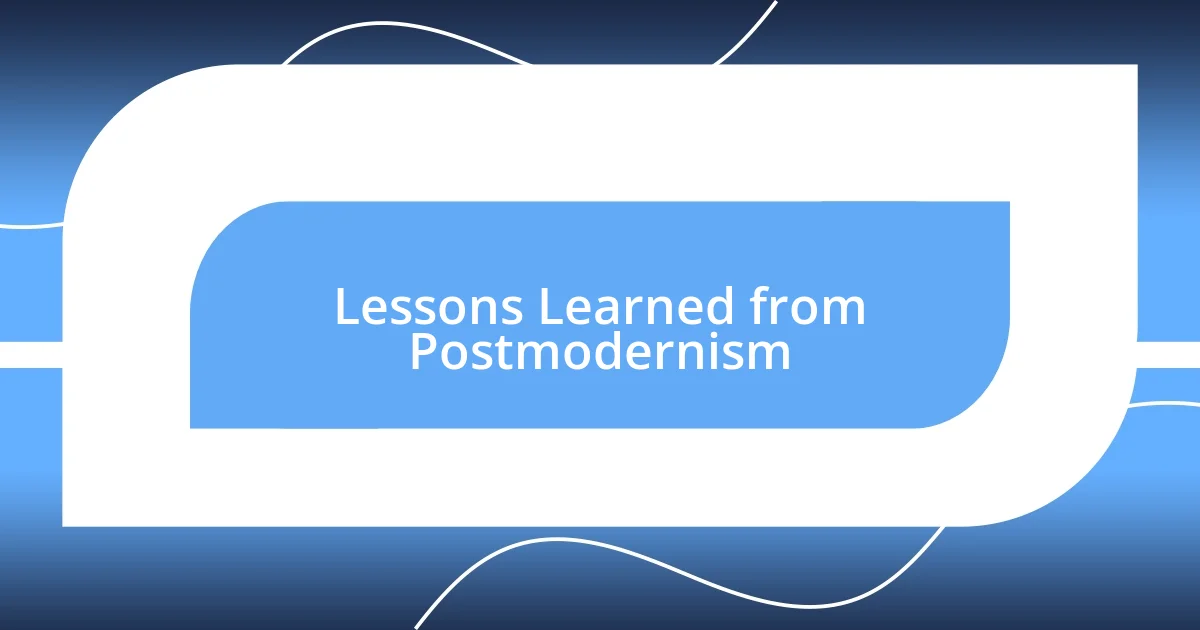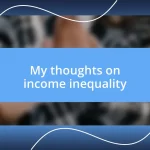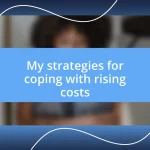Key takeaways:
- Postmodernism emphasizes the subjectivity of reality, encouraging diverse perspectives and challenging traditional narratives in art, literature, and culture.
- Key characteristics include intertextuality, pastiche, irony, relativism, and hyperreality, highlighting the complex and fragmented nature of human experiences.
- Engagement with postmodernist ideas promotes a critical approach to authority and societal norms, fostering innovation and deeper understanding through the acceptance of ambiguity and multiplicity.

Understanding Postmodernism
Postmodernism can often feel like a whirlwind of ideas, challenging traditional narratives and embracing the notion that reality is subjective. I remember the first time I encountered postmodern art; it was both bewildering and liberating. The way artists like Andy Warhol blurred the lines between high and low culture opened my eyes to the rich tapestry of meaning we can find in everyday objects. Have you ever stood in front of a piece of art that made you question what you really know? That feeling is at the heart of postmodernism – it provokes thought.
The movement itself often thrives on irony, paradox, and a playful attitude toward meaning. I once found myself discussing postmodern literature with a friend, and we laughed as we tried to pin down the narrative arc in Thomas Pynchon’s “Gravity’s Rainbow.” It was enlightening to realize that the chaos and fragmented storytelling echoed the complexities of modern life. Isn’t it fascinating how literature can mirror reality in such unconventional ways?
I’ve also come to appreciate how postmodernism encourages a sense of community through diversity of thought. During a recent gallery opening, I was struck by how each artist interpreted the same theme, showcasing a myriad of perspectives. It reinforced my belief that every voice has value and that embracing this multiplicity doesn’t dilute our experience; instead, it enriches it. Isn’t that what art and culture are meant to do – to bring us together in our shared humanity?

Key Characteristics of Postmodernism
When I reflect on the key characteristics of postmodernism, one stands out: the embrace of fragmentation. This idea really hit me during a visit to a contemporary art exhibit where each piece felt like a puzzle, each fragment telling part of a larger story. It reminded me that, much like our lives, narratives don’t always follow a linear path. This breaks away from traditional storytelling, highlighting the chaos and disarray of the human experience.
Here are some key characteristics of postmodernism:
- Intertextuality: Postmodern works often reference or borrow from one another, creating a web of connections that enriches meaning.
- Pastiche: A blending of styles or genres, showcasing an eclectic mix that resists categorization.
- Irony and Playfulness: Engaging with serious subjects through humor or absurdity, provoking a deeper reflection on societal norms.
- Relativism: Emphasizing that truth is subjective and varies from one perspective to another, challenging absolute narratives.
- Hyperreality: The blurring of the line between reality and representation, as seen in media and technology.
I remember feeling overwhelmed yet excited when I first encountered hyperreality in films like “The Matrix.” I left the theater questioning not just what was real but how our perceptions shape our understanding of the world. This dialogue between reality and representation is an exhilarating aspect of postmodernism that continues to resonate with me.

Influences of Postmodernism on Society
Postmodernism has profoundly influenced society by encouraging a critical approach to authority and tradition. I once attended a thought-provoking panel discussion where diverse voices challenged the status quo, making me realize how vital it is to question established narratives. Have you noticed how this questioning spirit fosters innovation? It’s like a ripple effect, sparking new ideas in politics, culture, and technology.
One of the most fascinating impacts of postmodernism is its role in shaping identity. I remember grappling with my own identity during a community workshop focused on storytelling. As participants shared their unique backgrounds and experiences, I felt a deep connection among us, illustrating how postmodernism amplifies individual narratives within a broader cultural context. This rich interplay between personal and collective identities is something I believe we all need to embrace for a more inclusive society.
In the realm of fashion and media, postmodernism’s influence is evident in the eclectic styles we see today. The last time I flipped through a fashion magazine, I was struck by the mash-up of influences from different cultures and time periods. This really resonates with me—how creativity can emerge from mixing and matching rather than adhering to rigid standards. Isn’t it exciting to witness a world where fluidity and diversity reign, reminding us to celebrate difference rather than conform? It’s these elements that make the postmodern era so transformative, encouraging us all to engage with the world around us on a deeper level.
| Influence | Description |
|---|---|
| Critical Approach | Encourages questioning of authority and tradition, leading to innovation across various fields. |
| Identity Shaping | Promotes the interplay between personal and collective narratives, fostering inclusivity. |
| Cultural Mashup | Celebrates diversity in styles and ideas, reflecting a fluid and eclectic cultural landscape. |

Personal Transformation through Postmodernism
Engaging with postmodernism has profoundly shifted my self-perception. I vividly recall a moment during a literature class when we unpacked the concept of intertextuality. As we analyzed various texts that played off each other, I realized how interconnected our thoughts and experiences are—like a tapestry woven from countless threads. It made me wonder: how much of what I believe is shaped by the voices and narratives around me?
The idea of hyperreality struck a personal chord when I often found myself lost in social media’s curated images. I remember scrolling through my feed, feeling a mix of envy and confusion about my own reality. That moment illuminated how easily we can blur the lines between real life and the representations we consume, challenging me to ground myself in authenticity. Have you ever had moments like this where you questioned the ‘realness’ of your experiences?
Finally, the playful irony that pervades postmodern thought has encouraged me to approach life with a sense of humor. I often reflect on a time when I tried to take myself too seriously during a workshop on creative writing. We were prompted to write absurd stories, and as I let go of my inhibitions, I discovered a newfound joy in self-expression. It left me questioning: why not embrace silliness in serious moments? This personal transformation through postmodernism has taught me that our narratives can be layered and complex, much like the art and literature we encounter.

Creative Expression in Postmodernism
Creative expression in postmodernism is a fascinating journey that reshapes our understanding of art and literature. I remember attending an experimental art exhibit where each piece seemed to challenge traditional boundaries. One installation, which used everyday objects in unexpected ways, nearly brought me to tears as it highlighted the beauty in the mundane. Isn’t it remarkable how creativity thrives when we allow ourselves to play with what’s familiar?
I’ve also explored how postmodern literature often blurs the line between genres. One day, I dove into a novel that seamlessly intertwined poetry, prose, and visual art. It felt as if the author was inviting me to dance through the pages—not merely reading but experiencing. This dynamic interaction made me wonder: how many ways can we convey a single idea? Perhaps it’s that very question that encourages more experimental storytelling and pushes us to expand our creative horizons.
Moreover, the concept of pastiche—a patchwork of different styles and influences—resonates deeply with my creative endeavors. I recall working on a personal project that borrowed elements from various artistic movements. The result was a piece that felt uniquely mine, yet echoed the voices of many. Have you ever tried mixing styles to create something entirely new? That sense of collaboration across time and cultures is what I cherish about postmodernism’s approach to creative expression—it’s an invitation to remix and reinvent in ways that reflect our individual truths.

Lessons Learned from Postmodernism
The lessons learned from postmodernism have profoundly reshaped my perspective on meaning and interpretation. I recall attending a seminar where the speaker emphasized the idea that “truth” is subjective and molded by context. It struck me—how often do I cling to my version of reality without considering alternative viewpoints? This revelation encouraged me to embrace diversity in thought, fostering a richer dialogue in my daily interactions.
One particularly captivating lesson from postmodernism is the acceptance of ambiguity. I reflect on a time when I was writing an essay and felt frustrated by the complex layers of meaning in my chosen text. As I examined it, I realized I could savor the uncertainty rather than rushing to find definitive answers. This experience taught me that sometimes the questions are far more stimulating than the answers. Have you noticed how life often doesn’t fit neatly into boxes?
Moreover, the critical lens that postmodernism applies to culture and society has made me more observant of the world around me. I remember watching a documentary that dissected a popular media phenomenon, revealing how it distorts our understanding of reality. The show ignited a fire within me to question mainstream narratives I once accepted uncritically. Now, I approach media with a skeptical eye, constantly asking, “What’s being left out?” That quest for deeper understanding is a powerful lesson I cherish from my journey through postmodern thought.

Applying Postmodernist Ideas Today
Applying postmodernist ideas today offers a refreshing lens through which to view our ever-evolving world. Just the other day, I was struck by a project that employed social media to create a collage of voices, capturing diverse opinions on a single event. It made me wonder: how can platforms like these cultivate a tapestry of experiences that reflects our complexity? This blending of perspectives is a testament to postmodernism’s ability to embrace multiplicity and challenge the singular narrative.
One of the most powerful applications of postmodern thought lies in its challenge to authority. I vividly recall a time when I attended a community forum where residents shared their frustrations with local governance. The stories shared were not just complaints; they intertwined personal experiences with broader social issues. It reminded me that every voice has validity and that grassroots storytelling can warrant significant change. How often do we forget that real conversations can uncover profound truths hidden beneath layers of formality?
Engaging with postmodernist ideas also means embracing technology as a transformative tool. I remember when I dabbled in creating a digital art piece using software that allows for constant iterations and changes. Each layer added created a new dimension, reminding me of postmodernism’s embrace of fluidity in art. This approach invites us to accept that perfection isn’t the ultimate goal—it’s the process of creation itself. Isn’t that a liberating thought? By allowing ourselves to experiment, we align closely with the postmodern spirit, celebrating the unexpected outcomes.














